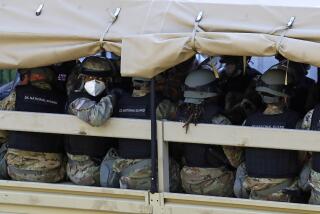Bush to Announce Decision to Reopen Reagan Airport
- Share via
WASHINGTON — President Bush has decided to reopen Reagan National, the only airport still closed three weeks after the Sept. 11 terrorist attacks, a White House official said Monday.
But the airport closest to the nation’s capital will face some of the stiffest security measures in the nation, including new flight patterns that take planes away from national landmarks such as the U.S. Capitol, lawmakers and aviation sources said.
Bush’s decision came after a White House meeting Monday with Virginia lawmakers of both parties who told him that permanently closing Reagan National would cost their state billions of dollars and that they would demand that his administration cover the loss.
“Closing the airport is a multibillion-dollar proposition at this point, and I don’t think that anybody wants to go there,” Rep. Tom Davis, (R-Va.), who represents a nearby suburban district, said after meeting with Bush.
Other members of Congress, many of whom fly from the airport to their home districts, had also urged the administration to keep the facility open.
Although an announcement from the president is expected as early as today, bringing the airport back to life could take from several days to more than a week, lawmakers said. Reagan National normally handles about 900 takeoffs and landings daily.
Before the hijackings, passengers who flew into Reagan National often glimpsed breathtaking views of the National Mall, the Washington Monument, the Capitol and the city’s broad boulevards. But security agencies have long regarded the airport as a major risk, since aircraft are literally seconds away from the White House, CIA and FBI headquarters and other nerve centers of government.
Defense Secretary Donald H. Rumsfeld, who supports reopening the airport, has said that effective security measures must be taken on the ground, since there is simply not enough time to intercept a jet that has been commandeered by hijackers near Reagan National’s runways.
Aviation sources and lawmakers said new security measures will be applied both on the ground and in the air.
At Reagan National, passengers, baggage and employees will receive closer scrutiny than at other airports. Passengers flying in from other parts of the country may also pass through a higher level of screening.
“We understand that National Airport really needs to be the safest airport in the world,” said Rep. James P. Moran (D-Va.), in whose district the airport is located.
Lawmakers said that a relatively high proportion of jets flying to and from Reagan National will likely have armed federal air marshals aboard.
Approach and departure routes from the airport in Arlington, Va., are also likely to change, lawmakers said. Previously, jets had followed the Potomac River to land and take off. That diminished the noise level in heavily populated Virginia and Maryland suburbs. But instead of relying solely on the river approaches, lawmakers said aircraft may now utilize several “scattered” routes that would take them over populated areas.
Controllers and pilots will also have to change their procedures. Jetliners approaching Reagan National would likely be required to identify themselves to local controllers while they are far away.
“Controllers are going to have to be confident that the right people are in control of the plane,” said an aviation safety source. “If they don’t get the proper response, or it’s not clear, that would give you a half hour to decide whether to shoot them down, instead of a few minutes.”
In the long run, jets could be outfitted with cockpit video cameras that can beam images of who is flying the plane to ground controllers.
The higher security could well reduce the number of flights serving Reagan National. But with 10,000 people employed at the airport and hundreds of millions of dollars recently invested in a major expansion, local leaders have been unanimous in lobbying for flights to resume. They have had strong support from members of Congress, who favor the convenience of Reagan National when traveling to their home districts.
Among the few dissenting voices has been the Aviation Consumer Action Project, an advocacy group founded by consumer activist Ralph Nader in the 1970s.
“This move would make the capital vulnerable to renewed aviation terrorist attacks and would send the message that the U.S. is not really serious about homeland defense,” said Paul Hudson, director of the advocacy group.
However, American Airlines Flight 77, which hit the Pentagon on Sept. 11, did not take off from Reagan National, but from Dulles International, about 30 miles west. And it flew as far as the Ohio-Kentucky border before turning back.
More to Read
Sign up for Essential California
The most important California stories and recommendations in your inbox every morning.
You may occasionally receive promotional content from the Los Angeles Times.













